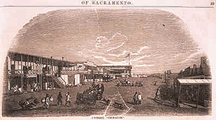

 The Chinese community
has been a long and important part of Sacramento's
history. Few Chinese accounts have survived the public record.
But within the Chinese community, newspapers, census data and
government documents are rich with the contributions of the Chinese.
The Chinese community
has been a long and important part of Sacramento's
history. Few Chinese accounts have survived the public record.
But within the Chinese community, newspapers, census data and
government documents are rich with the contributions of the Chinese.
Although they were not recorded in the first official census of 1850, the special state census taken 1852 showed there were 814 Chinese (804 males and ten females) in Sacramento that year. A later1860 census indicates that over 600 of the 814 Chinese lived in the city proper. The Chinese population in the city of Sacramento increased to 1,371 in 1870 and reached a peak 1,781 in 1880. The total county data on the Chinese in the nineteenth century is: 1
1860 1,731
1870 3,595
1880 4,892
1890 4,371
1900 3,254
Dates of the first Chinese to arrive in Sacramento vary. Early Sacramento Chinese immigrants were transient with other intents of migrating towards Marysville or heading for the gold country. But there were those Chinese who knew Sacramento would be their Gold Mountain. These early settlers from China were the merchants, restaurateurs, laundrymen, entrepreneurs, peddlers, and a conglomerate of other service-oriented people who served both the Chinese and the white community.
Sacramento's Chinatown was located on I Street from Second to Sixth Streets. The I Street area was the least desired part of town. Many thought of the area as a health hazard. Most Chinatowns were allocated by the white society from areas deemed as wasteland. But the Chinese saw that it was close to the harbor and close to the main business section. I Street, itself, was a levee road, the north bank backed onto Sutter Slough and both sides of the street laid on low ground. During flood stage Sutter Slough overflowed into the city streets and was a hazard. In the center of the slough the water was almost forty feet deep forming Sutter Lake. Flooding was a major hazard while living near the slough and the Chinese were flooded out periodically between 1850 and 1862. The presence of so many Chinese settling at Sutter Lake, the local Sacramentans began calling the area "China Slough." 2
Sacramento's Chinatown of the 1850s quickly became thriving
community. As early as 1851 the Sze Yup Association bought a building
on I street between Fifth and Sixth, next door, the association
provided temporary shelter for their fellow Chinese or those Chinese
in need of safety from a hostile general population. 3
One had to only follow the faint sound of Chinese music coming from the
rear of a social hall on I Street near Fifth Street to reach the
one hundred-seat room in the rear of the building to enjoy the
puppet show produced at the Canton Chinese Theater. The puppet
show gave way to live performances from theater troupes and their
accompanying traveling orchestras. The Chinese were willing to
share their love of the theater with the white population as a
form of goodwill whites were always invited to attend the performances.
Leong Ah Gue, manager and interpreter of a theater troupe scheduled
two performances on May 23, 1855, of Chinese historical operas
at the Sacramento Theater for an all-white viewing audience. In
1879 the Moor's Opera House, on Third Street between I and J streets,
served as a Chinese opera house; the performances began sharply
at 7:00 PM and continued until the early hours of the morning,
only a court order instigated by sleepy residents put an end to
their performances. However, within a week another Chinese theater
around the corner on I Street between Third and Fourth opened
their doors. 4
1. San Joaquin Republican, February 2 1853; 1860 U.S. Census (Washington: Gov't. Printing Office, 1864), pp 24-7: 1870 U.S. Census (Washington 1872), pp. 15, 91; (Washington l883), p.382, p. 416: 1890 U.S. Census (Washington, 1895) p. 437; 1900 U. S. Census (Washington, 1901) p. 565; Melform S. Weiss. Valley City: A Chinese Community In America (Cambridge, 1974), pp. 47-8.
2. Joseph A. McGowan, et. al, Report on the Historical Development of the City of Sacramento Blocks (Sacramento, 1978), p.1; Dorene Askin, Chinese Laundries (Sacramento, 1978), p. 6; John C. Jenkins, "Sutter Lake or China Slough," Golden Notes, December, 1966, pp.l-3; Mary Praetzellis and Adrian Praetzellis, Archeological Study of the IJ-56 Block, Sacramento. California: An Earlv Chinese Community (Sonoma, 1982), p. 17; Brienes, West and Schulz, Overview of Cultural Resources In the central Business District. Sacramento, California, 1981 (Sacramento, 1981), p. 61: William K. Willis, History of Sacramento County. California With Biographical Sketches (Los Angeles, 1913), p. 198.
3. Praetzellis, IJ56, p. 28.
4. Lois Rodecaper ''Celestial Drama in the
Golden Hills: The Chinese Theater in California 1849-1869",
California Historical Quarterly, June, 1944, p. 104; Sacramento
Bee, January 17, 1971: Cole, Capitalist Perspective, p. 20.